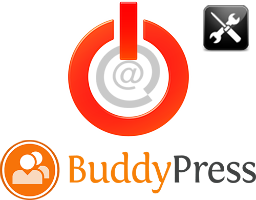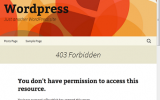
BuddyPress the social networking plugin for WordPress sends an activation email when a new user registers. This email is very plain so why not add some spice to it by having your custom email. There are many forum threads out there for this topic but 99% of them don’t mention if their method is for single site or multi site. So I spent a lot of time trying customize this activation mailer without any success. Finally I sank into the code of BuddyPress and found the right set of hooks for the each environment – single or multi site.
WordPress Single site
These are the filters that contain the necessary data.
- bp_core_signup_send_validation_email_subject
- bp_core_signup_send_validation_email_message
Changing the subject is pretty simple.
add_filter( 'bp_core_signup_send_validation_email_subject', 'custom_buddypress_activation_subject', 10, 2 );
function custom_buddypress_activation_subject( $subject, $user_id ) {
$user = get_userdata( $user_id );
return $user->user_login . ' – Activate your ' . get_bloginfo( 'name' ) . ' account';
}
To change the activation message –
add_filter( 'bp_core_signup_send_validation_email_message', 'custom_buddypress_activation_message', 10, 3 );
function custom_buddypress_activation_message( $message, $user_id, $activate_url ) {
$user = get_userdata( $user_id );
return "Hi $user->user_login,
Thanks for registering! To complete the activation of your account please click the following link:
$activate_url
Thanks,
Jesin";
}
This is a plaintext email, you can also send a HTML email. To do this the content type of the email has to be changed to “text/html”
function set_bp_message_content_type() {
return 'text/html';
}
add_filter( 'bp_core_signup_send_validation_email_message', 'custom_buddypress_activation_message', 10, 3 );
function custom_buddypress_activation_message( $message, $user_id, $activate_url ) {
add_filter( 'wp_mail_content_type', 'set_bp_message_content_type' );
$user = get_userdata( $user_id );
return 'Hi <strong>' . $user->user_login . '</strong>,
<br><br>
Thanks for registering! To complete the activation of your account please <a href="' . $activate_url . '">click here</a>.
<br></br>
Thanks,
Jesin';
}
The email’s Content-Type is to be modified only for the BuddyPress activation message, so we act on the wp_mail_content_type hook only inside this function.
You can also use full fledged email templates to give a branded feel.
WordPress Multisite
These are the hooks which contain the activation email and its subject on a Multisite setup.
Registration without blog.
- bp_core_activation_signup_user_notification_subject
- bp_core_activation_signup_user_notification_message
Registration with blog.
- bp_core_activation_signup_blog_notification_subject
- bp_core_activation_signup_blog_notification_message
The arguments passed by the filters are different here.
add_filter( 'bp_core_activation_signup_user_notification_subject', 'custom_buddypress_activation_subject', 10, 5 );
function custom_buddypress_activation_subject( $subject, $user, $user_email, $key, $meta ) {
return $user . ' – Activate your ' . get_bloginfo( 'name' ) . ' account';
}
Just choose the right pair of hooks depending on whether a blog is being created or not when a user registers.
add_filter( 'bp_core_activation_signup_user_notification_message', 'custom_buddypress_activation_message', 10, 5 );
function custom_buddypress_activation_message( $message, $user, $user_email, $key, $meta ) {
$activate_url = bp_get_activation_page() . "?key=$key";
$activate_url = esc_url( $activate_url );
return "Hi $user,
Thanks for registering! To complete the activation of your account please click the following link:
$activate_url
Thanks,
Jesin";
}
Adding this code
So where do you add this code? There are three options
bp-custom.php
This file resides in wp-content/plugins/bp-custom.php, if it not there create it and paste the required code. This is the method I recommend because it works in sync with the BuddyPress plugin and is not affected by change of themes. Also disabling BuddyPress will cause this file NOT to be loaded thus reducing the number of loaded files.
Create a plugin
You can create a file inside wp-content/plugins/ with the following plugin header and place the code after it.
<?php /* Plugin Name: BuddyPress custom activation email Plugin URI: https://websistent.com/custom-buddypress-activation-email/ Description: Checks the health of your WordPress install Author: Jesin A Author URI: https://websistent.com */
This gives the advantage of being able to disable this functionality if not needed.
Child Theme’s functions.php file
This is the least recommended location because changing the theme will result in lost of this functionality.




The filter for the message should be:
Why should the
$accepted_argsparameter be 5? This filter only passes 3 variables.Sorry was using a heavily modified version. However the naming convention is correct, the tutorial above works great for the subject line but not for the message.
So setting the fourth argument of
add_filter()to 5 made it work for you?No its the the change to the 1st argument which made it work.
You are hooking into:
bp_core_activation_signup_user_notification_message
It should be:
bp_core_signup_send_validation_email_message
This article explains both the filters, check under the single site and multisite headings. “bp_core_activation_ …” is for Multisite blogs and the one that worked for you is for single site.
Lol! Sorry Jesin, great post!!
Hey Jesin,
Ty for the post, it is very enlightening.
I was wondering if you could help me with something else. I would like the BP activation email to also send the new user his/hers username and password. Is that possible?
Ty very much.
Hi Allécto,
This post already uses the username in the example code snippets,
$user->user_loginprints the username.I can’t find a way for sending the password without editing the core files which I don’t recommend.
Hello, Jesin,
Thanks a bunch for your reply. Now the emails send the username, which was actually more important that the password.
Regards!
Hi Jesin,
Thanks very much for this article! I was trying to find out how to do this, ran across some very messed up articles, then found this one by simply Googling the text that BuddyPress sends out for an activation email! lol
Awesome, you have made my life much better. I can’t stand plain and jane. 🙂 This is perfect for my remodel of WinkPress.
Cheers!
hi, great post.
It was VERY helpful post, for me.
Especially:
function set_bp_message_content_type() {return 'text/html';} add_filter( 'wp_mail_content_type', 'set_bp_message_content_type' ); }Thank You.
Cheers.
Hi,
How to sync buddypress activation with Aweber activation (opt-in email) ?
I would like to send information enter since buddypress registration form to my contacts aweber when a user account is activated
What are the functions that allows to have the email, username, and the profile information for buddupress? and where is that I can put a function that sending this information?
Thanks,
Strange,
My website does send that email when somebody creates a new site :
“Thanks for registering! To complete the activation of your account and blog, please click the following link:…”
but I can’t find the file bp-custom.php.
I just want to locate and modify that email.
When can i find it?
Thanks for helping.
Editing the file is not the right way to do it, updating BuddyPress will overwrite the changes. Use the
bp_core_activation_signup_blog_notificationfilter as shown in this article to modify the mail text.Yes but I just want to edit the file for now. I think it is easy for me now.
Which file i have to edit?
Thanks.
Inside wp-content/plugins, create a file “bp-custom.php” with the following contents:
add_filter( 'bp_core_activation_signup_blog_notification_message', 'custom_buddypress_activation_message', 10, 8 ); function custom_buddypress_activation_message( $message, $domain, $path, $title, $user, $user_email, $key, $meta ) { $activate_url = bp_get_activation_page() . "?key=$key"; $activate_url = esc_url( $activate_url ); return "Hi $user, Thanks for registering! To complete the activation of your account and blog, please click the following link: $activate_url After you activate, you can visit your blog here: " . esc_url( "http://{$domain}{$path}" ); }Many Thks man! You saved my life 🙂
Great article. Thanks for this.
What about customising the title?
The default is [domain.com] Activate Your Account
Hi Mel,
Use the
bp_core_signup_send_validation_email_subjectfilter on single sites andbp_core_activation_signup_user_notification_subjectorbp_core_activation_signup_blog_notification_subjecton multisites. The article above covers these filters too.Thanks Jesin.
This is unfortunately beyond my current skills.
Would you have a snippet that works out of the box?
Greatly appreciated!
The snippet too is available in this article. This is for single site:
add_filter( 'bp_core_signup_send_validation_email_subject', 'custom_buddypress_activation_subject', 10, 2 ); function custom_buddypress_activation_subject( $subject, $user_id ) { return 'Your own subject line'; }Fantastic! Thanks
Hi Jesin
Thanks for this. I’m getting a weird issue though.
I created a plugin using the code. Locally it works fine. I can see in my mailoutput in XAMPP that the email has been created.
I am also testing a version of this on a subdomain on the live server, but here the reigstration email doesn’t sent. If I switch off the plugin the default activation email gets correctly sent. For some reason the exact same code isn’t working on the subdomain. Do you have any idea why?
Thanks
Hi Daniel,
It could be that the customized email is being marked as spam, did you check the junk folder of the recipient?
Hey! Yeah I did check the junk folder. When I switched off the plugin, the default Buddypress activation emails were coming through. Not sure why it isn’t working as it’s fine locally. I’m wondering if it is to do with it being on a subdomain.
Hi Jesin, this is a great snippet.
However I have a problem. The function works great when the user registers for the first time, the email is sent automatically and is displayed as it should; but if I try (as admin) to RESEND the activation mail to the new registered user, the $user->user_login variable is empty, it doesn’t show any value in the email message.
Do you have a solution for this?
Also, do you know how to show the user first_name instead of user_login? This doesn’t seem to work either.
Thank you!
Hi Jesin, thank you for your snippet .
I use the it on a single site in html version :
function set_bp_message_content_type() { return 'text/html'; } add_filter( 'bp_core_signup_send_validation_email_message', 'custom_buddypress_activation_message', 10, 3 ); function custom_buddypress_activation_message( $message, $user_id, $activate_url ) { add_filter( 'wp_mail_content_type', 'set_bp_message_content_type' ); $user = get_userdata( $user_id ); return 'Hi <strong>' . $user->user_login . '</strong>, Thanks for registering! To complete the activation of your account please <a href="' . $activate_url . '" rel="nofollow">click here</a>. Thanks, Jesin'; }Do you know a way to use it in to language english and french. I run for the moment a site in french but we plan to translate it in the next year.
Best regard,
Marc-Antoine
Sir Great tutorial
but i want to include username and password in email sent by buddypress after registering
Hi,
I would like to deactivate the activation of an account by email, when a user registers on my site, he is waiting, I would like the member to be automatically activated after his registration, do you know a php code or a plugin For it to work ?